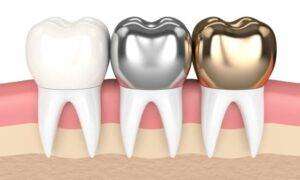Introduction-
Malocclusion results from poor alignment of the teeth and jaw, which is often genetic but can also be found in narrow teeth, rotten, decayed, or decayed teeth, dental work, bad or defective, and missing teeth, especially those that are missing. Habits such as thumb sucking, biting the lips or nails, clenching or grinding teeth can also contribute to problems. The absence of posterior teeth in an adult can cause or worsen a “deep bite,” which causes the bite and lower part of the face to break and give it a more prominent appearance.
The most common types of bite diseases are:
- an excessive deep bite
- a closed bite
- crossbite
- an open bite
- Crowding of teeth
- Protruding teeth
What is a deep bite?
- A deep bite is also called a closed bite or a deep bite. An abnormality in which the upper front teeth overlap the lower front teeth when the mouth is closed.
- There is a “bell shape” to the lower jaw line or arch of the teeth, in which the lower front teeth stand much higher than the lower back teeth and are sometimes sharp enough to bite into the gums on the roof of the mouth, resulting in gum recession around the upper teeth. A severe case of this can often lead to the loss of the front teeth.
Deep bites need to be corrected in order to improve dental function, facilitate brushing and flossing, and support the health of your teeth. As a result, your smile will also improve significantly.
Deep Bite Complications and Treatment
Deep excessive stinging causes anesthetic problems for some people and can make them feel insecure about their smile and teeth. Excessive deep bites may also cause various dental problems. In article we are discussing about Deep Bite Complications and Treatment.
The following complications can result from a deep excessive sting without treatment:
- Teeth that are worn down excessively.
- Dentition that destroys the gums and soft tissues around the teeth.
- Food chewing and biting problems.
- Headache and temporomandibular joint disorder (TMJ/TMJD)
- A painful sore or ulcer
- Tooth structure is lost.
- Deficiency of teeth
An issue with the temporomandibular joint is called temporomandibular joint disease. The result can be pain, discomfort, as well as a locking or clicking of the jaw. Other effects may include sleep disturbance and hearing problems.
Treatment for deep bites
- Restorative dentistry in general and orthodontics in particular are often needed for this purpose. In modern orthodontics, the front teeth can be pierced or the back teeth can be broken to correct a misaligned bite. There are a number of discreet methods available.
Orthodontics is available in Advanced Dentistry in the following ways:
- Concealed Orthodontic Devices (Linguistic)
- The conventional fixed orthodontic appliance (lips)
- Braces that are transparent
- Alignment that is transparent (e.g., Invisalign)
When the backs of the upper and lower front teeth wear badly from a “deep bite,” treatment often includes composite adhesives, veneers, or porcelain crowns, or sometimes the use of a Dahl device (some kind of removable orthodontic appliance). It is sometimes necessary to reinforce the closure of all teeth with composite bonds before moving on to ceramic, veneers, or crowns.
- Often, the absence of posterior teeth creates or worsens a “deep bite,” and to correct the bite, dental implants or bridges will be needed to replace the missing teeth.
- Surgery for orthognathic problems can be the only true solution in severe cases. Treatment options will depend on the extent of the deep bite, the profile of the face, and any future development. However, we always suggest the least invasive and permanent solution to meet your general needs.
EVIDENCE-BASED ON TREATMENT AND PRACTICE OF DEEP BITE
Orthodontic treatment of deep bites and posterior upper teeth in children by Declan T Millett
In summary, there is no evidence from clinical trials to support or discourage the use of orthodontics to correct Class II division 2 malocclusion in children.
Orthodontic Treatment with Clear Aligners and The Scientific Reality Behind Their Marketing: A Literature Review by Ipek Tamer
Clear aligners are an anesthetic and comfortable alternative to conventional fixed mechanics.
The correlation between periodontal health and clear aligners is greater and white spot lesions are less common during treatment.
Mild to moderate crowding cases can be treated with clear aligners, however, caution must be exercised in complex cases. In orthodontic treatments like aligner therapy, as well as fixed appliances, root resorption is still a risk.
Clear aligners in orthodontic treatment by T Weir
Conclusion- There is a wide range of options from which a clinician can choose if CAT is the desired treatment appliance. Because of the profound differences between these appliances, the decision to choose one particular appliance is a critical one conditioned on the severity of the malocclusion, the ability of the clinician to influence the final outcome, the speed and utility of the treatment, and the aesthetic and comfort characteristics of the appliance. The basic features of CAT systems, in general, have been described to assist clinicians in making an initial assessment of their clinical utility. We will not discuss laboratory fees or other clinical costs (for example chair time) associated with specific systems in this article.




